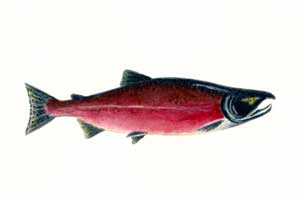Sockeye/Kokanee Salmon Features and Size

Ocean living, pre spawn Sockeye Salmon features are slim and elongated, much more so than the other Pacific Salmon. Although like all other Pacific Salmon they are silver from head to tail. The top is darker with a greenish blue coloration. When light shines off them, it gives a metallic or iridescent appearance.
Spawning Male Sockeye Salmon
The male Sockeye Salmon develops a hump, but it’s not as well pronounced as that found in the Pink Salmon. It’s head is an olive-black color and its entire body becomes a rich shade of deep red spreading into the fins.
The Sockeye’s color stands out so much that it is distinct from the other spawning salmon. The male Sockeye Salmon develops a hooked jaw and its teeth become longer and are very sharp. These are meant for defensive and offensive purposes rather than feeding as they don’t feed once they are spawning.
Spawning Female Sockeye Salmon
The female turns the same bright color as the male Sockeye, but without the hump. The female is also smaller in appearance to the male. Unlike the male, the female doesn’t develop a hooked jaw, although it does have the sharpened long teeth.
Freshwater Kokanee Salmon
Kokanee Salmon undergo the same physical characteristics as the ocean going Sockeye Salmon. However they’re smaller in size.
Sockeye Salmon Size
The all tackle record for the largest Sockeye Salmon ever caught was 15.3 pounds/6.88 kilograms and was caught in Kenai River in Alaska, in the United States. It was caught by Stan Roach.
The average Sockeye caught generally weighs between 4 to 8 lbs or 1.81 to 3.63kg and can reach 33 inches/83.82cm in length.
Gill Arch Rakers
The Sockeye Salmon has 28 to 40 long and slender gill arches that are serrated. Other salmon have a different amount of gill arches and not all have serrated edges. To compare, Chum for instance only has between 19 to 26 gill arches that are short and stout.
*Wondering what is a gill raker? There’s a good explanation here.



